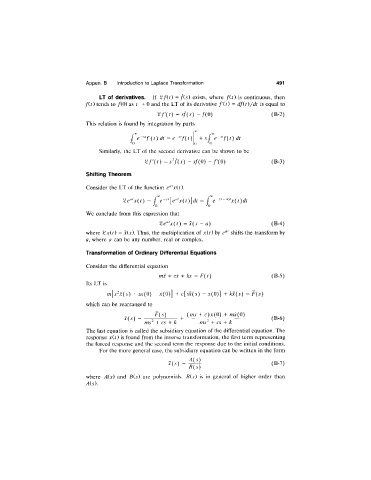Page 504 - Thomson, William Tyrrell-Theory of Vibration with Applications-Taylor _ Francis (2010)
P. 504
Appen. B Introduction to Laplace Transformation 491
LT of derivatives. If 2 /(0 = is) exists, where fit) is continuous, then
f
fit) tends to fiO) as / 0 and the LT of its derivative f'it) = dfit)/dt is equal to
z n t ) = s f { s ) - m (B-2)
This relation is found by integration by parts
oc
i e^^'f'{t)dt = e-'”f (t ) + s f e~^'f{t)dt
•'o 0 •'()
Similarly, the LT of the second derivative can be shown to be
S /"(/) = 5 ^ (5 ) - i/( 0 ) -/'(O ) (B-3)
Shifting Theorem
Consider the LT of the function e‘"x{t).
2e''^x(r) = \ xit)\dt = f e~^^~''^^xit)dt
•'o *^0
We conclude from this expression that
Ze^^xit) =x is - a) (B-4)
where Zxit) = xis). Thus, the multiplication of xit) by shifts the transform by
a, where a can be any number, real or complex.
Transformation of Ordinary Differential Equations
Consider the differential equation
m x c x k x = F i t ) (B-5)
Its LT is
m[s^xis) - ^^(O) - i(0)] + - x(0)] + kxis) = Fis)
which can be rearranged to
F{s) ims -f c)jc(O) + mi(0)
Jt(5) + (B-6)
ms^ cs k ms^ cs -h k
The last equation is called the subsidiary equation of the differential equation. The
response xit) is found from the inverse transformation, the first term representing
the forced response and the second term the response due to the initial conditions.
For the more general case, the subsidiary equation can be written in the form
Ajs)
x(s) (B-7)
B{s)
where /l(i) and B(s) are polynomials. Bis) is in general of higher order than

